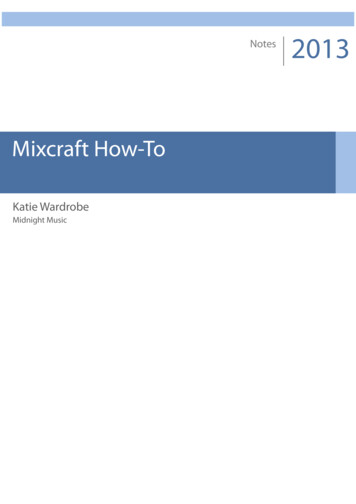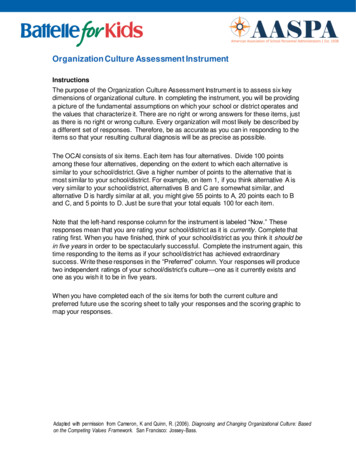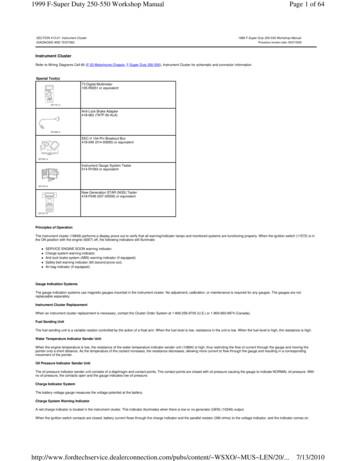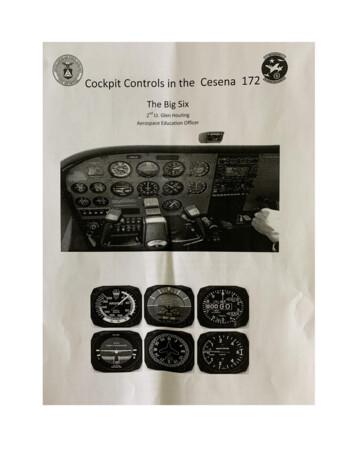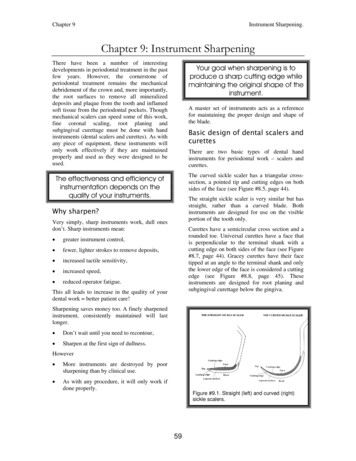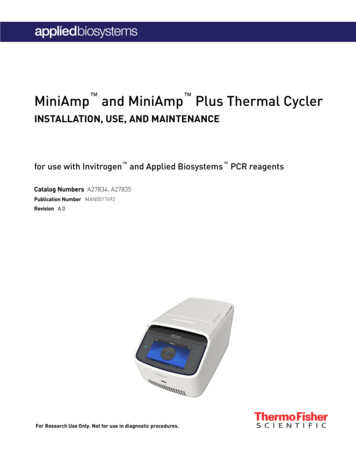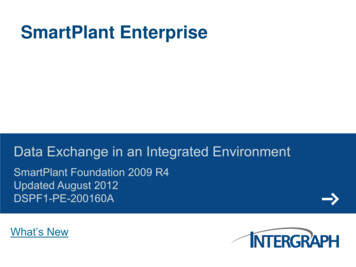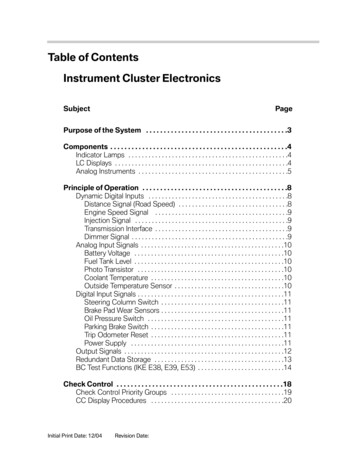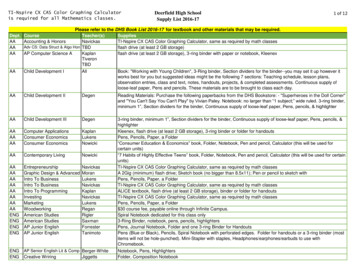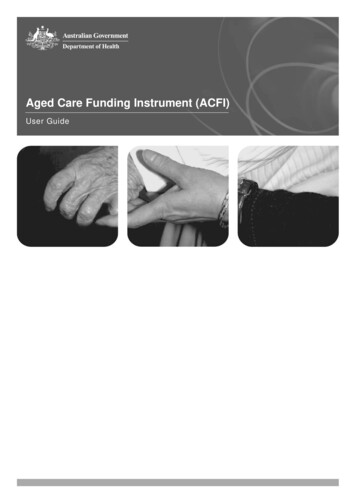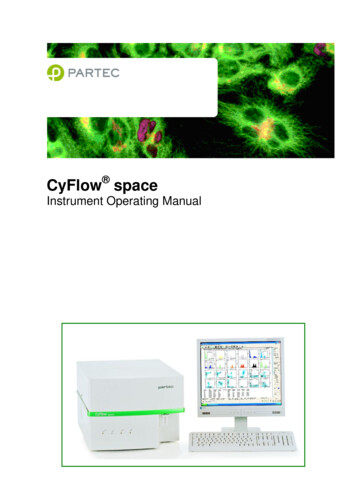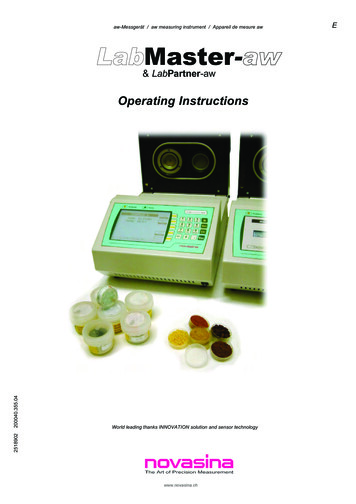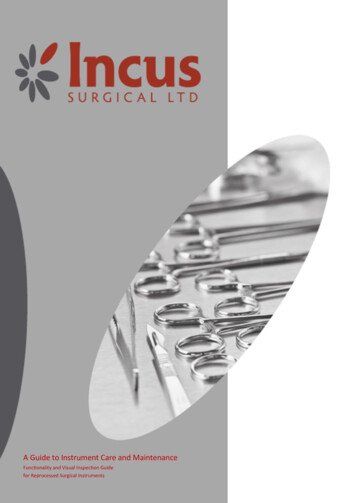
Transcription
A Guide to Instrument Care and MaintenanceFunctionality and Visual Inspection Guidefor Reprocessed Surgical Instruments
Incus Surgical LimitedMabrook House, Bocking End, Braintree, Essex, CM7 9AAT: 01376 347300 F: 01376 349718 E: info@incus-surgical.comA Guide to Instrument Care and MaintenanceFunctionality and Visual Inspection GuideFor Reprocessed Surgical e Myth about Stainless Steel4Materials4Quality Control5Developing a Comprehensive Care Programme81—Cleaning and erilisation10Trouble Shooting and Identifying Problems11VersionChange Doc.Title01NewQMF7.34A – Instrument Care GuideAuthorised by:Page No.2
IntroductionSurgical Instruments represent a significant material asset within the overall investment of a hospital. The care andmaintenance that these instruments receive is critical to their performance during surgery and to the cost containmentefforts of each hospital authority.Having made the investment in a quality product, the authority can expect several years of trouble-free use if the operatorutilises proper techniques during use, care, and handling of its surgical instruments.This guide has been produced based on the requirements of ‘EN ISO 17664 – Sterilisation of Medical Devices – Informationto be provided by the manufacturer for the processing of re-sterilisable medical devices’, and is designed to help prolongthe functional capability and value of these instruments and should be used in conjunction with the individual hospitalpolicy for cleaning and sterilising.The following instructions are to provide general guidance for the visual inspection and manual testing followingreprocessing of reusable Class 1r, non-measurable, non-sterile surgical instruments manufactured by Incus Surgical Limitedand is intended for use by persons with the required specialist knowledge and training.It is the responsibility of the re-processor to ensure that the reprocessing is performed using the equipment, materials andpersonnel in the reprocessing facility achieve the desired result. This requires validation and routine monitoring of theprocess. Likewise, any deviation by the re-processor from the instructions provided must be properly evaluated foreffectiveness and potential adverse consequences.To help reduce the cost and expenses associated with surgical instruments, many hospitals are finding that prevention isbetter than cure. As a result, more and more healthcare institutions are developing specific standards and programs forproper instrument maintenance and care.One such programme is ‘Planned, Preventative Maintenance’ – a bespoke repair, refurbish or replace service that IncusSurgical Limited can tailor to meet your surgical instrument care needs.For more information email: info@incus-surgical.com or call 01376 347300.Date01.10.19VersionChange Doc.Title01NewQMF7.34A – Instrument Care GuideAuthorised by:Page No.3
An understanding of the materials used to manufacture instruments, and its characteristics, coupled together with asound knowledge regarding correct reprocessing procedures will result in a trouble free, long lasting life for yourSurgical instruments.The myth about stainless steel:Around 75% of all surgical instruments used today are made of stainless steel. It resists rust, can be honed to a finepoint and retains sharp edges. Unfortunately, the term “stainless” steel is frequently taken too literally.It does have its weaknesses, water spotting and staining to name but two. There is really no “stainless” type of steel.During the manufacturing process a step known as passivation provides the instrument with its corrosion resistanceproperties. Passivation, which follows the final polishing steps, is a chemical bath that creates an oxidised layer on thesurface of the instrument.Through routine hospital use and exposure to the air this oxidation process continues, effectively maintaining and evenbuilding up a barrier to most stains and corrosive elements. Therefore, we sometimes hear the remark “They don’t makeinstruments like they used to; my old instruments don’t seem to stain or mark like these new ones do!”The fact is that the older instruments are extremely well protected by a very effective layer of chromium oxides whichhave been strengthened by the repeated exposure to oxidising conditions that exist during reprocessing.Materials:Stainless Steel:The steel used in most surgical instruments is a 400 series alloy that has several useful properties. It can be brought to a verysharp cutting edge and will hold this edge through continuous use. It has a high tensile strength enabling it to maintainprecisely set jaw approximations. The metal is often referred to as stainless because of its corrosion resistance qualities.It usually has a Chromium content of 11.5% - 18% which gives the steel some of its stainless characteristics and thepercentage of carbon gives the various hardness required for maintaining sharp edges on instruments.The stainless steels used in the manufacture of surgical instruments can be divided into two main classes:1: Austenitic (Non-magnetic)2: Martensitic (Magnetic)Non-magnetic stainless steel is used in the manufacture of instrument such as tongue depressors, Sims Speculum etc wherehardness is not important. It contains less carbon steel and so is less susceptible to corrosion and staining. Grade 304 S12sheet metal and grade 303 S21 rod are used in the manufacture of all instruments in this category.Magnetic stainless is used for most of all other instrument manufacture. i.e. scissors, forceps, retractor blades etc.Grade 420 S29 is used for forceps, dissectors, retractor blades etc.Grade 420 S37 is used for screwdriver shafts, bone punches etc.Grade 420 S45 is used for instruments with cutting edges, scissors, chisels, osteotomes etc.Other Materials Used in Surgical Instrument Manufacture are:Brass Grade CZ121, used for instruments such as uterine sounds and suction tubes.Sterling Silver 95% Hallmark quality , used for items such as tracheostomy tubes and catheters etc.A blackening process known by the term Ebanol Process is used to obtain a non-reflective finish of aural forcepsand micro instrument and instruments used in laser surgery.Date01.10.19Version01Change Doc.TitleNewQMF7.34A – Instrument Care GuideAuthorised by:Page No.4
Quality ControlThe stainless used in the manufacture of Incus instruments meet the specifications set out previously in British Standards andnow in and BS EN ISO 7153-1:2016 Part One – Surgical Instruments – Materials. The carbon level also complies with thesestandards.Throughout the manufacturing process the instruments undergo many rigorous quality assurance tests.All forgings are inspected to ensure dimensional accuracy and that correct annealing has been achieved. Annealing is a processthat brings the raw forging to the correct hardness for machinability and to minimise the grain size which enables bettersurface finishing of the instrument. This process is achieved by heat treatment bringing the forging to a correct temperaturefor a specific time usually within a vacuum furnace.All instruments made from Martensitic stainless are heat treated and hardened by the vacuum process. Once hardened eachbatch is random tested for correct harness requirements according to the Rockwell scale.Once the instruments have passed the final inspection stage, they are then etched with our company name, ultrasonicallycleaned to remove all final traces of manufacturing and polishing debris and finally lubricated as necessary.All our workshops adhere to the current criteria required by BS EN 13485:2016 and additionally we have met the additionalcriteria set by the MDR745:2017 for CE Marking our Class 1R Non-sterile, Non-measurable Surgical Instruments.Incus Surgical Limited instruments are manufactured by highly skilled craftsmen who strive to produce reliable, durableinstruments that surpass all expectations. We believe our adherence to stringent manufacturing and Quality Assuranceprocedures coupled with the use of high-grade conforming materials ensure that any instrument bearing the Incus Surgical Ltdname will meet the demand of even the most discerning operator.Date01.10.19Version01Change Doc.TitleNewQMF7.34A – Instrument Care GuideAuthorised by:Page No.5
Developing a Comprehensive Instrument Care ProgrammeThe simple four step solution to instrument care:1. Cleaning and Disinfecting2. Lubrication3. Inspection4. Sterilisation1. Cleaning and DisinfectingDisinfection of soiled instruments not only helps topreserve the instruments themselves but also serves toprotect the persons responsible for their transportationand cleaning. Wherever possible, instruments should bedisinfected and cleaned immediately after use. Anysoiling left to dry will make eventual cleaning far moredifficult and could result in damage to the instrument.Caustic agents and medicines e.g. iodine preparations,silver nitrate, mercury and solutions high in chlorides canbe used in operating rooms and other medicalprocedures. These agents are highly corrosive and shouldbe removed as soon as possible from the surface of theinstrument. Under no circumstances should instrumentsbe over exposed or stored in any physiological salinesolution as prolonged contact causes pitting rust.See figure 1.Figure 1: Pitting and CorrosionIf manual handling of instruments to be cleaned and disinfected hasto be carried out then the instructions of the chemical manufacturermust be strictly adhered to regarding concentration, temperatureand exposure time.Special attention should be paid to the manufacturers instructionsregarding compatibility of materials such as anodised aluminiumotherwise corrosion of surfaces of the anodised item would occur.See Figure 2.Figure 2: Corrosion of Anodised AluminiumDate01.10.19Version01Change Doc.TitleNewQMF7.34A – Instrument Care GuideAuthorised by:Page No.6
Cleaning and Disinfecting continued.Always use fresh disinfecting and cleaning solutions as directed. Prolonged use of the same solution may cause: corrosion due to soiling corrosion due to increasing concentration of chemical caused by evaporation decrease in the effectiveness of disinfection agent due to excessive level of soilingPowdered disinfecting products must be completely dissolved prior to immersing any instruments sinceundissolved particles may lead to clogging of narrow lumens and box locks and to discolouration of the instrumentsurface.Following manual chemical disinfection, instruments must be thoroughly rinsed in fresh running water to removeall residues. No metal brushes or scouring products should be used. The final rinse should be in distilled ordemineralised water to reduce the risk of water spots and finally, instruments should be thoroughly dried.Machine cleaning and disinfection is usually carried out by the CSSD when the instruments are received forreprocessing in a dry state. If they need to be transported in a wet state then a low foaming chemical must beemployed as high foam levels can influence the effectiveness of cleaning.The temperature of the inflowing water must never exceed 45 C as higher temperatures lead to proteincoagulation.Again, the manufacturer’s instructions as to the concentration, temperature and exposure time, of the cleaning ordisinfection agent must be strictly adhered to. The popular belief of thinking that the more chemical is used thenthe more effective it must be should be immediately dispelled!Using the correct dosage not only guarantees a proper disinfection and cleaning result but also protects thematerial of the instrument against excess alkaline or acidic pH levels. Corrosion and pitting can occur withimbalanced pH values.When machine washing, special attention should be paid to the following:i) hinged instruments must always be open to allow thorough cleaningof the jointsii) ensure that cleaning trays/baskets are not overloadediii) any instruments with lumens must be placed so as to allow throughflow of cleaning agents and rinse wateriv) place large instruments in such a way as to avoid ‘shadowing’ ofother instrumentsv) ensure dissimilar metals are not in contact with each other which cancause contact corrosions.See figure 3.Figure 3: Contact CorrosionDate01.10.19Version01Change Doc.NewTitleQMF7.34A – Instrument Care GuideAuthorised by:Page No.7
Cleaning and Disinfecting continued The rinse cycle phase is very important. Any debris washed off the instrumentsmust be removed from the final rinse otherwise spotting and discolouration mayoccur.Temperatures of between 70 C and 90 C has proved to give the best results butif bad water quality is suspected then the temperature should be limited tobetween70 C and 75 C.The use of demineralised water in the final rinse stage will avoid water spotsand discolouration and there would be no requirement to limit temperature ofthis stage. See Figure 4.Immediate drying, whether by machine or other means, is essential to avoidfurther spotting and possible corrosion occurring due to evaporation of wateron the surface of the instrument.Figure 4: Discolouration2. LubricationEven the most careful cleaning can sometimes still leave an instrument stiff or hard to work. Even if all blood anddebris have been removed, mineral deposits and other impurities from the water system can collect on theinstrument and may cause staining, rusting and corrosion.To guard against the hazards endured during sterilization and storage a reputable instrument lubricant must beapplied to all working surfaces and moving parts of all instruments.Ultrasonic cleaners remove all traces of lubricants from an instrument and it istherefore particularly important to apply a lubricant during every recyclingprocess.The programme used for applying lubricant is up to the individual institution but itcould be applied either manually or automatically during the final rinse stage ofautomated washers.Lubrication helps prevent the friction of metal on metal which would lead tofretting corrosion.See Figure 5.Figure 5: Fretting CorrosionDate01.10.19Version01Change Doc.NewTitleQMF7.34A – Instrument Care GuideAuthorised by:Page No.8
3. InspectionThe importance of inspecting each instrument can not be overemphasised.Each surgical instrument is designed for a specific purpose. Inspection has to be carried out to ensure that they stillfunction as they should. If in any doubt, the manufacturer should be contacted to advise on suitable inspectionmethods.Fine and delicate instruments should be inspected under an illuminated microscope. In order to avoid damageduring handling at this stage place the instruments on specially designed racks and holders to prevent themknocking together, especially the tips of sharp instruments.All hinged instruments such as clamps and forceps should be checked for stiffness and to ensure the joints worksmoothly. The tips of instruments should be of equal length, jaws close evenly, approximate initially at the tips andbe fully approximated when closed to the last ratchet.There should be no excess play in any box joints and the ratchets should operate smoothly, hold firmly, even whenknocked, and open easily.The edges of sharp and semi sharp instruments such as scissors, ronguers, chisels, curettes etc should be inspectedfor sharpness.Scissors should close smoothly with no ‘grinding’ around the pivot pin. There should also be no dull spots, chips ordents in the cutting edges.Plated instruments must be checked for chips, as this would harbour debris, and also for sharp edges and wornspots. Sharp edges will damage tissue, surgeon’s gloves and worn spots may be susceptible to rusting and corrosionduring sterilization.All instruments with pins and screws should be carefully checked to make sure they are completely intact andsafely located.A General Guide on How to Inspect InstrumentsForceps and Heamostats: A visual test would be to close the jaws lightly. If they overlap they are out of alignmentand need re-aligning. If the forceps have serrated jaws they should be checked to see that they mesh fully.There should be no play in the box joint of the instrument.The ratchet should be closed and the instrument held by the box and tapped lightly on the other hand. If theratchet springs open it is faulty and in need of repair. (this would not be ideal if the haemostat were on a vesseland sprung off when knocked by a hand or other instrument!)Scissors: The standard test for all operating scissors should be applied. All Mayo and Metzenbaum type scissorsshould cut four layers of gauze at the tip of the blade.Smaller scissors of less than 10cm in length should cut two layers in the same way.Blades: These should be checked for burs and they should be in good approximation all the way down the length.There should not be excessive fretting around the pivot pin which would lead to possible corrosion and breakage.Needle Holders: A needle should be clamped in the jaw and the instrument closed to the second ratchet. If theneedle can be moved or turned easily then the instrument needs repairing.Date01.10.19Version01Change Doc.NewTitleQMF7.34A – Instrument Care GuideAuthorised by:Page No.9
4. SterilizationGood cleaning and lubricating practises will help eliminate many of the problems that arise with surgicalinstruments but if metallic ions or alkaline residue collects on the instrument during sterilization then staining andcorrosion will result.An impure water source, improperly maintained sterilizer, or improperly processed surgical wrappers are all majorsources of the impurities which can stain and corrode instruments. Most water sources are unsuitable for use inthe generation of steam without some kind of pre-treatment.In order to guarantee steam quality then the recommendations of pr EN285 regarding the quality of water in thetank, as well as the condensate, should be adhered to otherwise rust particle from the conducting system maycause corrosion or too high a level of silicic acid may lead to discolouration of the instruments.Methods are usually employed to remove solids, alter hardness and control the presence of dissolved oxygen andcarbon dioxide. The water is then further treated so that when it is turned into steam it can be used throughoutthe hospital for heating and returned to the boiler for reuse.Unfortunately, unless these treatments are carried out very carefully the delivered steam may have unfavourableeffect on both the instruments and the sterilizer itself.Good quality steam at the correct pressure, as recommended by the manufacturer, is essential, not only for a long,trouble free life of the instrument but also that of the equipment.Sometimes good quality steam is delivered to the sterilizer but staining and corrosion still develop. These problemsmay be caused by the linen wraps used in the preparation of trays for sterilization. The washing, rinsing and finaltreatment of linen used for this purpose must be understood and the best possible methods strictly adhered to.Condensation is a necessary process for successful steam sterilization. If the instruments have not been completelyrinsed so that no chemicals remain on their surfaces then staining and corrosion may occur as these residuals arealtered in the presence of high temperature steam.Proper drying cycles and strict adherence to the equipment manufacturers recommendations are essential toprevent the formation of excessive moisture and the resulting water spotting which will lead to staining andcorrosion.Date01.10.19Version01Change Doc.NewTitleQMF7.34A – Instrument Care GuideAuthorised by:Page No.10
Trouble Shooting & Identifying ProblemsA well written procedure will assure the correct care and handling process of surgical instruments. Proceduresshould be presented in as much detail as possible listing every step of the procedure and the equipment andsupplies to be used.Liaison with other departments is also essential, particularly the Maintenance Department – you should alwaysknow when there is any work being carried out on the water, or steam supply to your department as this couldhave impact on the cleaning and sterilizing process.If a problem arises first check to see that all procedures have been adhered to.Never use short cuts when caring for instruments, the result could be costly to put right when rusting, staining andcorrosion happen as a result.Be aware that rusting of one instrument doesn’t necessarily identify your problem totally. There are many modernalloys and so called stainless steels in use today but even these can rust through the transfer of rust particles fromnon-stainless steel items.Many instrument problems such as corrosion on blades, box joints and between two moving surfaces can usuallybe attributed to one or more of the following: inadequate cleaning and drying immediately after use corrosive sterilizing solutions or too long an exposure to sterilizing solutions ordinary tap water rather than demineralised or distilled water in the cleaning and sterilizing process incorrect detergents being used some fault within the autoclaveSurfaces which cannot be effectively polished are usually more prone to corrosion. Typically, knurled or groovedhandled instruments may rust on the handle while the remainder of the instrument remains unaffected. Even thesatin finish used to reduce operating light glare is more prone to discolouration than highly polished instruments.This sort of discolouration and marking can be simply removed by scrubbing with a suitable instrument cleaningbrush and appropriate detergent. If this is not effective the instrument can be re-polished and passivated by themanufacturer.Some oxidation, i.e. rusting, may occur during autoclaving while the instrument is exposed to air, moisture andheat. Some of this rust can be attributed to water left in areas of an instrument that is difficult to dry. Alwaysensure thorough drying to alleviate this.Be aware that instruments may corrode more in one hospital than they do in another indeed even in onedepartment more than another. This can be traced to the mineral content of the water which varies from onearea to another.Date01.10.19Version01Change Doc.NewTitleQMF7.34A – Instrument Care GuideAuthorised by:Page No.11
Recognising Spotting, Staining & Corrosion ProblemsLight Coloured Spots:Can be caused by water droplets condensing on the surface of the instrument and evaporating very slowly. Usuallythis can be traced to the mineral content of the water – particularly sodium, calcium and magnesium.Can be rectified by following the autoclave manufacturers guide to the letter. The door should never be openeduntil all steam has been exhausted from the chamber. A leaky door gasket or valve may cause water droplets tocondense as a result of an improper drying cycle.Dark Coloured Spots:Can be caused by – in most cases these are caused by the same situations as light coloured spots.Can be rectified by ensuring all solutions for cleaning, disinfecting, rinsing and sterilizing are prepared with distilledor demineralised water, free of any chlorides and to a pH value near to 7.0.Rust Coloured Film:Can be caused by – some water softeners may cause rust coloured, dust like, film to occur under certain conditions.Also some areas have a high concentration of iron compounds in the water and this can be deposited on thesurface of the instrument. In some new hospitals, foreign matters left inside steam pipes during installation cancause apparent rusting. Virtually nothing can be done about this but it is usually a temporary situation whichshould subside within two to three months.Can be rectified by – consult with hospital engineering staff.Bluish Grey Stains:Can be caused by – in the main part—cold sterilizing solutions. rectified by – changing the solution as frequently asrecommended by the manufacturer. Prolonged use will permit the solution to become corrosive.Using distilled water and a rust inhibitor will minimise discolouration but the manufacturers directions must bestrictly adhered to.Brownish Stains:Can be caused by a chromic oxide film forming on the stainless steel when it is heated giving the instrument a dullblue, but usually brownish, cast.Frequently this discolouration can be traced to the instrument sterilizer. Many hospitals use dish washingcompound compatible with their local water supply. However, many of these are polyphosphates which have acopper solubilizing action on parts of the sterilizer and this layer of copper is deposited on the surface of theinstrument by electrolytic action.Can be rectified by trying to use other suitable compounds and ensuring that quantities are accurately measured.Corrosion (Rust):Can be caused by – insufficient rinsing of operating room linens and wraps after the laundry has used causticchemicals. Instruments wrapped in these linens may absorb these caustic residues during reprocessing.Can be rectified by checking with the laundry service and ensuring adequate rinsing of operating room linens.Date01.10.19Version01Change Doc.NewTitleQMF7.34A – Instrument Care GuideAuthorised by:Page No.12
Recognising Spotting, Staining & Corrosion Problems continued.Stiff Box Joints and/or Ratchets:Can be caused by issues such as dried blood in box joints, serrations and ratchets that then appears like rust. It isusually baked on and, left untreated, will lead to cracking of the box joint.Can be rectified by ensuring particular care is given to cleaning box joints and pivoting.Instruments where blood and debris can be missed during cleaning.Can be caused by excessive moisture left on the surface of the instrument, in box joints or crevices while wrappedin sterile packs. This can be due to a poor drying cycle or improper loading of the sterilizer.Can be rectified by ensuring the sterilizer is preheated. Never compromise or shorten the drying stage of the cycle.Ensure the correct depth of vacuum is achieved and held for the correct period of time so that instruments aresensibly dry when they come to leave the sterilizer. Also have engineering check that there are no leaks from anypart of the sterilizer.Remember that rust cannot be rinsed off. It is impossible to completely restore instruments after rusting or pittinghas eroded the hard surface. Once the surface has been compromised by pitting it is far more susceptible tofurther corrosion.PREVENTION IS BETTER THAN CURERemember the four steps to Instrument Care & Maintenance1. Clean and Disinfect2. Lubricate3. Inspect4. SteriliseIf you would like to know more about Incus Surgical Limited’s ‘Planned, Preventative Maintenance’ – a bespoke repair,refurbish or replace service tailored to meet your surgical instrument care needs contact us today:E: info@incus-surgical.comT: 01376 347300.Date01.10.19Version01Change Doc.NewTitleQMF7.34A – Instrument Care GuideAuthorised by:Page No.13
Illustrations of further examples of Corrosion, Spotting and Staining:Figure 6: Chloride Induced PittingFigure 7: Chloride Induced PittingFigure 9: Stress Corrosion CrackingFigure 10: Stress Corrosion CrackingDate01.10.19Version01Change Doc.NewFigure 8: Staining due to a highConcentration of minerals.TitleQMF7.34A – Instrument Care GuideFigure 11: Crevice CorrosionAuthorised by:Page No.14
Illustrations of further examples of Corrosion, Spotting and Staining—continued.Figure 12: Crevice CorrosionFigure 13: Silicate CoatingFigure 15: Discolouration and Rustingdue to poor cleaningFigure 16: Pitting due to CausticSolutionDate01.10.19Version01Change Doc.NewFigure 14: Black tintsTitleQMF7.34A – Instrument Care GuideFigure 17: Pitting due to CausticSolution—magnifiedAuthorised by:Page No.15
Illustrations of further examples of Corrosion, Spotting and Staining—continued.Figure 18: Pitting CorrosionFigure 19: Pitting Corrosion—magnifiedIf you would like to know more about Incus Surgical Limited’s ‘Planned, Preventative Maintenance’ – a bespoke repair,refurbish or replace service tailored to meet your surgical instrument care needs contact us today:E: info@incus-surgical.comT: 01376 347300.Date01.10.19Version01Change Doc.NewTitleQMF7.34A – Instrument Care GuideAuthorised by:Page No.16
Surgical instruments. The myth about stainless steel: Around 75% of all surgical instruments used today are made of stainless steel. It resists rust, can be honed to a fine point and retains sharp edges. Unfortunately, the
